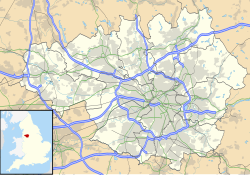| Guide Bridge | |
|---|---|
 St Stephen's Church, Guide Bridge | |
Location within Greater Manchester | |
| Population | 1,659 (2001 census) [1] |
| • Density | 15.99 hm2 |
| OS grid reference | SJ924976 |
| Metropolitan borough | |
| Metropolitan county | |
| Region | |
| Country | England |
| Sovereign state | United Kingdom |
| Post town | ASHTON UNDER LYNE |
| Postcode district | OL7 |
| Dialling code | 0161 |
| Police | Greater Manchester |
| Fire | Greater Manchester |
| Ambulance | North West |
| UK Parliament | |
Guide Bridge is an area of Audenshaw, west of Ashton-under-Lyne, in Greater Manchester, England. [2] Historically part of Lancashire, Guide Bridge was built as a village around an eponymous bridge over the Ashton Canal. [3]

